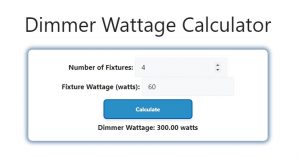About Dimmer Wattage Calculator (Formula)
A Dimmer Wattage Calculator is a useful tool for anyone looking to install or replace dimmer switches in their home or office. Dimmer switches allow for customizable lighting levels, enhancing the ambiance and energy efficiency of a space. However, using the right wattage for your dimmer is crucial to ensure safety and proper functionality. This calculator helps determine the maximum wattage that a dimmer can handle based on your lighting configuration.
Formula
The formula to calculate dimmer wattage (DW) is:
Dimmer Wattage (DW) = Number of Fixtures (F) * Fixture Wattage (FW) * 1.25
This formula ensures that you consider the total wattage of your fixtures and add a safety margin for optimal performance.
How to Use
- Count the Number of Fixtures (F): Determine how many light fixtures will be connected to the dimmer switch.
- Identify Fixture Wattage (FW): Find out the wattage rating for each fixture (typically labeled on the bulb or fixture itself).
- Apply the formula: Multiply the number of fixtures by the fixture wattage.
- Multiply by 1.25: This accounts for safety, ensuring that the dimmer can handle slight overloads.
- Analyze the result: The resulting wattage will help you choose the correct dimmer switch for your lighting needs.
Example
Suppose you have four light fixtures, each rated at 60 watts. Using the formula:
DW = F * FW * 1.25
DW = 4 * 60 * 1.25
DW = 300 watts
In this case, you would need a dimmer switch rated for at least 300 watts to ensure safe and effective operation.

FAQs
- What is a Dimmer Wattage Calculator?
It is a tool that calculates the appropriate wattage rating for dimmer switches based on the total wattage of connected fixtures. - Why is wattage important for dimmers?
Using the correct wattage ensures that the dimmer can handle the electrical load safely without overheating or failing. - What does the formula take into account?
The formula accounts for the number of fixtures, their wattage, and includes a safety margin of 25% to prevent overloading. - Can I use this calculator for LED lights?
Yes, the calculator can be used for LED lights, but ensure the dimmer is compatible with LED technology for optimal performance. - What happens if I exceed the recommended wattage?
Exceeding the recommended wattage can cause the dimmer to overheat, leading to potential fire hazards and reduced lifespan of the dimmer. - Do all dimmers have the same wattage capacity?
No, dimmers come with different wattage ratings, so it’s essential to check the specifications of the dimmer switch you plan to use. - How can I determine the fixture wattage?
Fixture wattage is usually labeled on the bulb or within the fixture’s documentation. If unsure, consult the manufacturer’s specifications. - What if I have mixed wattage fixtures?
Use the highest wattage fixture when calculating, or adjust the formula based on the total wattage of all fixtures combined. - Is it safe to use a dimmer with incandescent bulbs?
Yes, dimmers are safe to use with incandescent bulbs as long as the total wattage does not exceed the dimmer’s capacity. - Can I use a standard dimmer with smart bulbs?
Not all standard dimmers are compatible with smart bulbs. Always check the manufacturer’s recommendations for compatibility. - What types of dimmers are available?
Dimmers come in various types, including standard, smart, and three-way dimmers, each designed for specific applications. - Do I need to hire an electrician to install a dimmer?
If you are comfortable with basic electrical work, you can install a dimmer yourself. Otherwise, hiring a licensed electrician is advisable. - Can I use a dimmer with fluorescent lights?
You can use a dimmer with fluorescent lights if they are specifically designed for dimming. Standard fluorescent bulbs are not compatible. - What is the benefit of using a dimmer?
Dimmers provide control over light intensity, enhancing comfort, mood, and energy efficiency, potentially lowering electricity costs. - How do I know if my dimmer is overloaded?
Signs of an overloaded dimmer include flickering lights, dimmer overheating, or tripped circuit breakers. - Is it necessary to use the 1.25 multiplier in the formula?
Yes, the 1.25 multiplier adds a safety margin to account for any potential fluctuations in wattage. - What if my fixtures have a combined wattage lower than the dimmer’s rating?
It’s perfectly fine; the dimmer will simply provide less power than its maximum capacity, allowing for future upgrades. - Are there dimmers specifically designed for low-voltage lighting?
Yes, there are dimmers designed for low-voltage systems, so it’s essential to select the right type for your lighting setup. - Can I use a dimmer for outdoor lighting?
Yes, but ensure that the dimmer is rated for outdoor use and compatible with the types of bulbs used. - How often should I check my dimmer settings?
It’s a good practice to periodically check your dimmer settings and wattage, especially if you change bulbs or fixtures.
Conclusion
A Dimmer Wattage Calculator is an invaluable resource for selecting the appropriate wattage for your dimmer switches, ensuring safety and optimal performance. By understanding the wattage requirements and utilizing the formula provided, you can enhance your lighting experience while maintaining energy efficiency. Proper installation and selection of dimmers contribute to a comfortable, well-lit environment tailored to your needs.